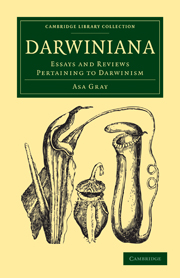Book contents
- Frontmatter
- PREFACE
- Contents
- ARTICLE I THE ORIGIN OF SPECIES BY MEANS OF NATURAL SELECTION
- ARTICLE II DESIGN versus NECESSITY—A DISCUSSION
- ARTICLE III NATURAL SELECTION NOT INCONSISTENT WITH NATURAL THEOLOGY
- ARTICLE IV SPECIES AS TO VARIATION, GEOGRAPHICAL DISTRIBUTION, AND SUCCESSION
- ARTICLE V SEQUOIA AND ITS HISTORY: THE RELATIONS OF NORTH AMERICAN TO NORTH-EASTERN ASIAN AND TO TERTIARY VEGETATION
- ARTICLE VI THE ATTITUDE OF WORKING NATURALISTS TOWARD DARWINISM
- ARTICLE VII EVOLUTION AND THEOLOGY
- ARTICLE VIII “WHAT IS DARWINISM?”
- ARTICLE IX CHARLES DARWIN: SKETCH ACCOMPANYING A PORTRAIT IN “NATURE”
- ARTICLE X INSECTIVOROUS PLANTS
- ARTICLE XI INSECTIVOROUS AND CLIMBING PLANTS
- ARTICLE XII DURATION AND ORIGINATION OF RACE AND SPECIES
- ARTICLE XIII EVOLUTIONARY TELEOLOGY
- INDEX
ARTICLE II - DESIGN versus NECESSITY—A DISCUSSION
Published online by Cambridge University Press: 05 October 2010
- Frontmatter
- PREFACE
- Contents
- ARTICLE I THE ORIGIN OF SPECIES BY MEANS OF NATURAL SELECTION
- ARTICLE II DESIGN versus NECESSITY—A DISCUSSION
- ARTICLE III NATURAL SELECTION NOT INCONSISTENT WITH NATURAL THEOLOGY
- ARTICLE IV SPECIES AS TO VARIATION, GEOGRAPHICAL DISTRIBUTION, AND SUCCESSION
- ARTICLE V SEQUOIA AND ITS HISTORY: THE RELATIONS OF NORTH AMERICAN TO NORTH-EASTERN ASIAN AND TO TERTIARY VEGETATION
- ARTICLE VI THE ATTITUDE OF WORKING NATURALISTS TOWARD DARWINISM
- ARTICLE VII EVOLUTION AND THEOLOGY
- ARTICLE VIII “WHAT IS DARWINISM?”
- ARTICLE IX CHARLES DARWIN: SKETCH ACCOMPANYING A PORTRAIT IN “NATURE”
- ARTICLE X INSECTIVOROUS PLANTS
- ARTICLE XI INSECTIVOROUS AND CLIMBING PLANTS
- ARTICLE XII DURATION AND ORIGINATION OF RACE AND SPECIES
- ARTICLE XIII EVOLUTIONARY TELEOLOGY
- INDEX
Summary
D. T.—Is Darwin's theory atheistic or pantheistic? or, does it tend to atheism or pantheism? Before attempting any solution of this question, permit me to say a few words tending to obtain a definite conception of necessity and design, as the sources from which events may originate, each independent of the other; and we shall, perhaps, best attain a clear understanding of each, by the illustration of an example in which simple human designers act upon the physical powers of common matter.
Suppose, then, a square billiard-table to be placed with its corners directed to the four cardinal points. Suppose a player, standing at the north corner, to strike a red ball directly to the south, his design being to lodge the ball in the south pocket; which design, if not interfered with, must, of course be accomplished. Then suppose another player, standing at the east corner, to direct a white ball to the west corner. This design also, if not interfered with, must be accomplished. Next suppose both players to strike their balls at the same instant, with like forces, in the directions before given. In this case the balls would not pass as before, namely, the red ball to the south, and the white ball to the west, but they must both meet and strike each other in the centre of the table, and, being perfectly elastic, the red ball must pass to the west pocket, and the white ball to the south pocket.
- Type
- Chapter
- Information
- DarwinianaEssays and Reviews Pertaining to Darwinism, pp. 62 - 86Publisher: Cambridge University PressPrint publication year: 2009First published in: 1876



